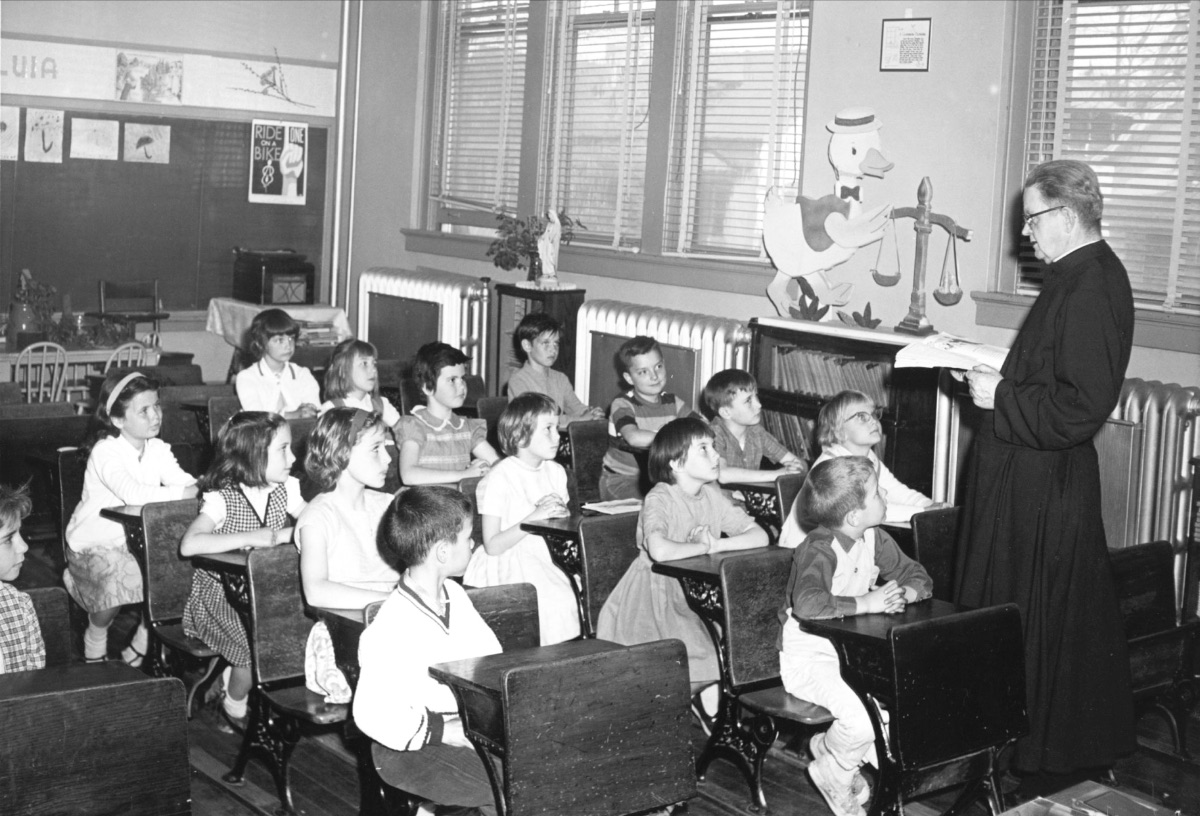Catholic Schools Tomorrow
“The then-U.S
 “The then-U.S. Office of Education wrote in a 1903 report that the system of Catholic free parochial schools was the most impressive religious fact in the country at that time.” I sighted this quote in a review of Parish School: A History of American Catholic Parochial Education from Colonial Times to the Present, a book by Timothy Walch. The bureaucrat writing in 1903 was not observing just any old fact, but instead the "most impressive religious fact in the country." Indeed, the educational system of which the bureaucrat wrote was a very big deal then, and it survives, though diminished, into our time.
“The then-U.S. Office of Education wrote in a 1903 report that the system of Catholic free parochial schools was the most impressive religious fact in the country at that time.” I sighted this quote in a review of Parish School: A History of American Catholic Parochial Education from Colonial Times to the Present, a book by Timothy Walch. The bureaucrat writing in 1903 was not observing just any old fact, but instead the "most impressive religious fact in the country." Indeed, the educational system of which the bureaucrat wrote was a very big deal then, and it survives, though diminished, into our time.
The school system that survives, however, struggles to remain “impressive” on any scale. Betsy Shirley, in a recent America article titled “Catholic Schools Reimagined,” highlights this reality with her subheading-shocker: “The era of the parochial school—at least in the form that has dominated Catholic education in recent memory—is over.” Here, “over” signals “the end.” The schools aren’t dead per se, but their era, their positive contexts, their ability to be taken-for-granted are all in the past. Catholic schools may survive in some form, but they will be unrecognizable to what came before. Shirley, an editor of the non-Catholic Sojourners magazine, does not write in gleeful triumph, as her Protestant coreligionists of a century ago might have done. Instead, she joins the company of empathic citizens who care about faith, education, the civil order, and the future in general, such that her writing about Catholic schools shows appreciation for the good they've done, is honest about the problems they face, and conveys the concern and ambivalence with which they face what comes next.
The signs of our times inspire little hope here. Catholic schools are in grave trouble, as Shirley points out. Some reasons for decline—beginning in the 1960s—can be easily discerned: The touted religious revival “is over.” Catholic population centers in many cities have scattered to the suburbs or been weakened by secularizing forces. The sexual abuse scandals in the Catholic priesthood, which need no noting here, have certainly contributed to the drastic diminution in the ranks of the priesthood, while also simultaneously diminishing the “authority” Americans once perceived in the priesthood. Shock waves which took shape in works like Mary Perkins Ryan’s shattering critique from 1964, Are Parochial Schools the Answer?, continue to make headaches and headlines. And the tight financial situation of many parishes, the main sponsors and supporters of parochial schools, render expensive day-school programs burdensome and often impossible to bear.
Perhaps unsurprisingly, much of the positive-leaning commentary on this subject includes descriptions (and prescriptions) that rely on the formula of attaching the prefix “re-“ to one or several verbs. So Shirley’s article purports to be “re-imagining,” while other commentators engage in “re-thinking” or “re-designing.” They receive notice and inspire some innovation. And to be honest, Catholic and other faith communities have actually engaged in some of this “re-“ work, innovating old religious forms in efforts to counter the secularism which seems to characterize so much in American life. Faith-based nursery schools play some positive part, though they are unable to provide access to the stories, parables, codes of conduct, worship experiences, and communal spirit, among other things, which parochial schools, for all their faults, provided by educating and forming generations of citizens in a pluralistic society. (A personal intrusion: I was an ancient [1933-41] satisfied customer/consumer of parochial education, though of a kin, Lutheran brand.)
Lest all hope should be lost, Shirley reports on some relatively successful experiments in the world of Catholic education, even though no single trend has yet proven strong enough to carry the burden of the parochial system. It would seem that increased religious tolerance would bode well for the future of Catholic parochial schools—Shirley writes: “the threat of anti-Catholic bigotry [is] no longer on parents’ minds”—and yet we would do well to remember that anti-Catholicism was in fact one of the leading forces that inspired Catholics to create and support their own schools in the first place, carving out spaces in the nation where their children could be sheltered from the “anti-“ forces. Thus, while we might hope and work for a re-newing of the unique gifts that Catholic parochial education once gave us, we should also be careful that we are not re-producing the forces that necessitated the system in the first place. Here’s to re-imagining, against most, not all, odds.
 Author, Martin E. Marty (PhD’56), is the Fairfax M. Cone Distinguished Service Professor Emeritus of the History of Modern Christianity at the University of Chicago Divinity School. His biography, publications, and contact information can be found at www.memarty.com. Author, Martin E. Marty (PhD’56), is the Fairfax M. Cone Distinguished Service Professor Emeritus of the History of Modern Christianity at the University of Chicago Divinity School. His biography, publications, and contact information can be found at www.memarty.com. |
Sightings is edited by Joel Brown, a PhD student in Religions in America at the Divinity School. Sign up here to receive Sightings via email. You can also follow us on Facebook and Twitter.


